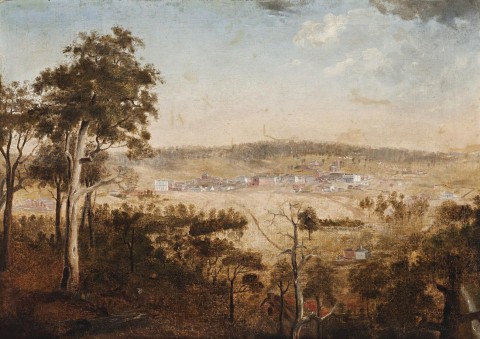VIEW OF GOULBURN, 1846
JOSEPH BACKLER
oil on canvas
80.0 x 100.0 cm
Probably: Hugh Bonython, Adelaide
Private collection, Melbourne
Thence by descent
Private collection, Sydney
On loan to the Queensland Art Gallery, Brisbane, 1987 (label attached verso, owner: Mr W. Rice)
If the eighteen-year-old Londoner, Joseph Backler, caught and convicted for passing forged cheques, had not had his death sentence commuted to transportation for life, Australian art, especially portraiture, would have been much poorer. A prolific painter, Backler, had to go through further privations, including nine years at Port Macquarie, place of secondary punishment, before receiving his ticket of leave. On the good side were his landscapes of the settlement, including St. Thomas' Church, Port Macquarie (Mitchell Library, State Library of New South Wales, Sydney), as well as marriage to Margaret Magner in that same church in 1842. Back in Sydney, he remained there until we learn from an advertisement in the Sydney Morning Herald of 30 August 1845 that he was in Goulburn offering his services as a portrait painter.1 Contact is given in the name of ‘J. Sinclair’ Goulburn. Today, a portrait of James Sinclair by Backler is also in the collection of the Mitchell Library.
The presence of an artist in Goulburn in 1846 aroused considerable interest. Even more so two, the Sydney Morning Herald reporting on the activities of Backler and a ‘…Mr. Ellis, who has recently come amongst us’.2 Both painted views of Goulburn, that of Backler’s arousing much comment. Believing our painting to be the same, the newspaper reported that his landscape was ‘much admired’; but raised the matter of the railway line to Sydney, much talked about at the time. Mr Backler has:
… given us the benefit of railways by introducing a locomotive with its train, steaming along: but being too much in advance of the times, and the gentleman for whom it was painted wishing a correct representation of the town as it is, the locomotive is to be put hors de combat, which will no doubt give satisfaction to the croskers: it was painted, however, before Mr. Woore’s report appeared, but he and the artist seem both to have been of one mind as to the whereabouts the terminus should be at this end.3
Thomas Woore was a leading pastoralist near Goulburn. When the colonial government refused to have a survey undertaken for the proposed railway, Woore had possible routes investigated at his own expense. The results were reported to a meeting in Sydney in August, much in time with Backler’s painting. The subsequent government wranglings and failure of the venture became part of history, as has the painting. The topographical spread of the town is picturesquely arranged with towering gums to frame the composition, historic Georgian buildings positioned in their best view. The ‘unrivalled’ Goulburn Hotel, opened by Nathan Mandelson in 1846, is prominent in white, two-storied splendour. Mandelson had substantial interests in the same company proposed for the construction of the private railway, meetings being held in the hotel’s ballroom. Prominent among the other buildings is the Anglican Church of St. Saviour, designed by the Sydney architect, James Hume.
Crowned by a square western tower, it was built of red brick in 1840 to a characteristic English design. Replaced in 1874 by the present Gothic-styled cathedral designed by Edmund Blacket, the church’s bricks were reused in the cathedral’s floor. From Goulburn, Backler went forward to other towns, painting landscapes of Bathurst c.1847 and Tenterfield 1861, and many other portraits.4
1. ‘Goulburn’, Sydney Morning Herald, 30 August 1845, p. 1
2. ‘Goulburn. Fine Arts’, Sydney Morning Herald, Sydney, 1 September 1846, p. 2
3. ibid. The French phrase ‘hors de combat’ translates as ‘out of the fight’
4. (View of Bathurst from Victoria Cottage Farm), c.1847, oil on canvas mounted on composition board, 55 x 88.5 cm, in the collection of the Mitchell Library (ML973), State Library of New South Wales, Sydney; (View of Tenterfield), 1861, oil on canvas, 66.5 x 89 cm, private collection
DAVID THOMAS
